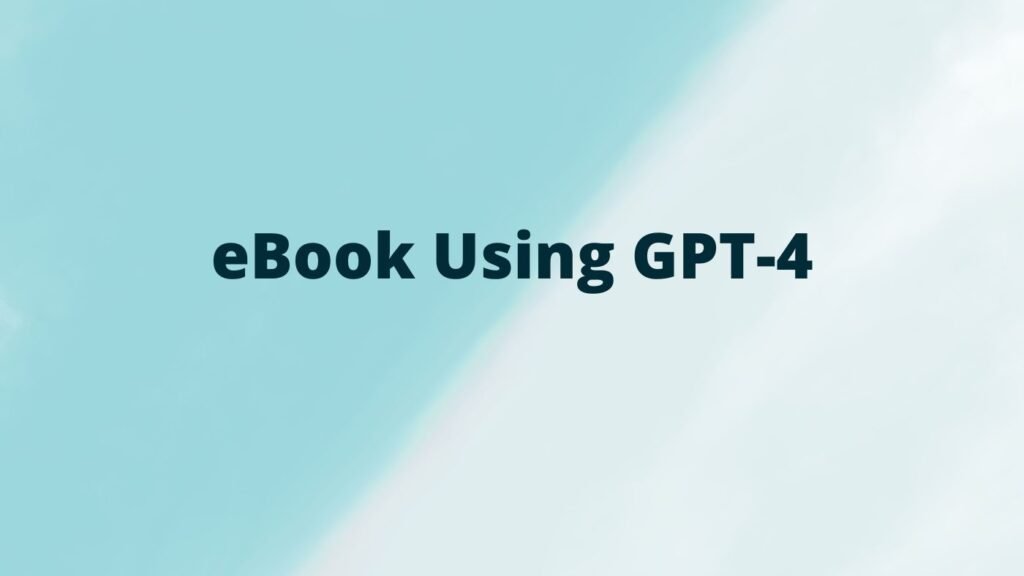Introduction:
As artificial intelligence continues to evolve, its use cases extend far beyond our imaginations. Ebook using GPT-4 is one of the most intriguing applications of AI in content generation, specifically with tools like GPT-4 from OpenAI. As a language model, GPT-4 can write comprehensive and meaningful content, making it an excellent tool for creating an eBook. This guide aims to walk you through a step-by-step process of writing an eBook using GPT-4.
What is GPT-4?
Generative Pre-trained Transformer 4, or GPT-4, is a cutting-edge AI developed by OpenAI. It is an AI model that leverages machine learning algorithms to understand and generate human-like text. Trained on a variety of internet text, GPT-4 can generate human-like text in response to the prompts provided by the user.
Step 1: Defining Your eBook Topic
Before starting the writing process, you need to define the topic of your eBook. The choice of topic will depend on your target audience, market demand, and your knowledge of the subject. For instance, if your audience comprises entrepreneurs, your eBook could revolve around the theme of ‘Starting a Business’. To utilize GPT-4, you would then have to form a prompt related to this topic.
Step 2: Creating a Structure
Having a well-defined structure is crucial when creating an eBook. The structure should include a table of contents, chapters, and sub-chapters. It helps organize the content and provides a roadmap for GPT-4. For instance, a structure for our eBook could look like this:
- Introduction to Entrepreneurship
- Identifying Business Opportunities
- Creating a Business Plan
- Sourcing Financing
- Building a Team
- Marketing Your Business
- Conclusion
Step 3: Writing with GPT-4
To write with GPT-4, you need to provide it with a prompt. The AI model will then generate text based on the input. It’s important to phrase your prompt correctly to get the desired output. For instance, to start writing the first chapter ‘Introduction to Entrepreneurship’, your prompt could be: “Write an introductory chapter explaining the concept of entrepreneurship, its importance, and key characteristics of successful entrepreneurs.”
GPT-4 will then generate a human-like text that can be used as the content of the chapter. This process can be repeated for each chapter in your structure.
Step 4: Refining and Editing
Although GPT-4 generates high-quality content, it is crucial to review and edit the output. Look out for any inaccuracies, logical inconsistencies, or stylistic issues. Keep refining until the content matches your desired quality and style.
Step 5: Adding Value
While GPT-4 provides the bulk of the content, adding personal insights, case studies, or anecdotes can significantly enhance the value of your eBook. This personal touch will not only improve your eBook’s quality but also make it more relatable for your audience.
Step 6: Formatting and Designing
Once the content is ready, the next step is to format and design your eBook. While GPT-4 handles the writing, you’ll need to use an eBook editing tool for this phase. Tools like Canva or Adobe InDesign can help you design an attractive layout, add images, and design the cover.
Conclusion:
AI language models like GPT-4 have revolutionized the world of content creation. By combining the power of AI with a well-planned strategy and personal insights, one can leverage these tools to create a comprehensive and engaging eBook. However, remember that while GPT-4 can generate content, the editing, designing, and marketing stages still require a human touch. But by taking care of the time-consuming process of drafting, GPT-4 provides a significant boost to the eBook creation process. Whether you’re an established writer or a beginner, this AI tool can help you become a published eBook author in no time.

